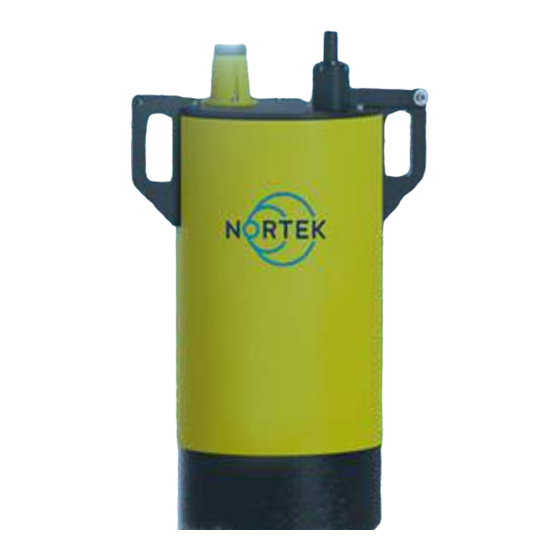
Table of Contents
Advertisement
Quick Links
Advertisement
Table of Contents

Summary of Contents for Nortek AOS
-
Page 2: Table Of Contents
Table of Contents 1 Introduction 2 Technical specifications 3 Included in the delivery 4 Function description 5 Mounting Nortek AOS buoy 6 Deployment and mooring 7 Setup webpage 8 Change batteries 9 Maintenance 10 Service and repair © 2018 Nortek... -
Page 3: Introduction
AOS data, and through a cloud hosted web application (www.aos.nortek.no), you will always find your updated real time data. The Nortek AOS Buoy is built to withstand rough treatment and includes a radar reflector. In addition there is an option to install a blinking signal light. -
Page 4: Technical Specifications
400mm Length 2500mm Sensor contacts 1*8-pin (Aquadopp Profiler) and optional 1*5/6-pin (oxygen-/salinity sensor) Power Batteries 6 * 100 Wh alkaline batteries (Nortek) Environment Operating temperature - 20°C til + 45°C Data communications Data transfer Iridium Current measurements Nortek Aquadopp Profiler. Further details in data sheets. -
Page 5: Included In The Delivery
7. Blinking light (if ordered) In addition to the main components, the following is included: 2-pin/2-pin cable from AOS tube to battery tube 8-pin/8-pin cable from Aquadopp Profiler to battery tube 2-pin cable from battery tube to blinking light (if ordered) -
Page 6: Function Description
Battery tube: Contains 6 * 100 Wh alkaline (not rechargeable) batteries. The batteries are connected to the battery tube when shipped from Nortek. In other words, there is no need to connect the batteries to the battery tube first time the AOS buoy is deployed. -
Page 7: Mounting Nortek Aos Buoy
Picture 1: a) Blinking light mounting, b) AOS tube mounting, c) Output AOS tube 2: To mount the AOS tube on the top cover of the buoy: First mount the clamp in the available hole in the top cover, and thread the tube halfway through the cover (1b). The antenna on the AOS tube should point in the same direction as the blinking light. - Page 8 (5). Picture 5: a) Place the cables in the indent of the battery tube collar. b) Mount the cable from the AOS tube and the cable from the blinking light to the battery tube. c) Use the supplied locking splints to fasten the...
- Page 9 Mounting Nortek AOS buoy 10: Fasten 2-pin cable from the AOS tube to the battery tube (5b). Fasten the 2-pin cable from the blinking light to the battery tube. 11: Use two of the supplied locking splints to fasten the battery tube to the inside of the buoy.
-
Page 10: Deployment And Mooring
Nortek Sensor Buoy Deployment and mooring Nortek AOS buoy can be mounted at great depths and in strong currents. We have modeled and collected data based on tests of the hydrodynamic behavior during typical current environments. The table with the data collected (see below) can be used as a guidance for deployment. - Page 11 10 m 300 kg 60 m 250 m 10 m 300 kg 65-70 m 300 m 15 m 350 kg 80-90 m 400 m 20 m 450 kg 125 m 500 m 20 m 600 kg 140 m © 2018 Nortek...
-
Page 12: Setup Webpage
Nortek Sensor Buoy Setup webpage Note the stationID for the AOS tube. The 4-digit number is the final test documentation and it is written on the AOS tube. Log in to www.aos.nortek.no with username and password and access the data after the Nortek AOS buoy is deployed. -
Page 13: Change Batteries
We recommend to have a spare battery tube available, in that way, the battery tube is the only component to change in the field. This is to avoid changing exposed batteries in field environments. © 2018 Nortek... -
Page 14: Maintenance
Oxygen Sensor: If the oxygen sensor(s) shows unnatural or unstable values, it may be a sign that recalibration is required. A simple test can be done before contacting Nortek: Test the sensor in a saturated solution. For example, use a bucket of tap water. Note that water from the tap will typically be over-saturated, so wait for approx. - Page 15 Maintenance Salinity Sensor: The salinity sensor cannot be calibrated. The current profiler cannot be recalibrated. Contact Nortek if it is suspected that the instrument is not measuring correctly, and Nortek can perform a service/verification. Storage: The sensors and the instruments must be stored with care and protected against careless relocation/handling.
-
Page 16: Service And Repair
Invoice address Telephone Email Important! Freight insurance in connection with repairs is not covered by Nortek. Make sure the equipment is adequately insured before shipping. Please note that sensors exposed to severe mechanical stress (vibration/shock), may reduce target accuracy significantly and may be destroyed if they are not properly packaged. - Page 17 Service and repair © 2018 Nortek...
Need help?
Do you have a question about the AOS and is the answer not in the manual?
Questions and answers